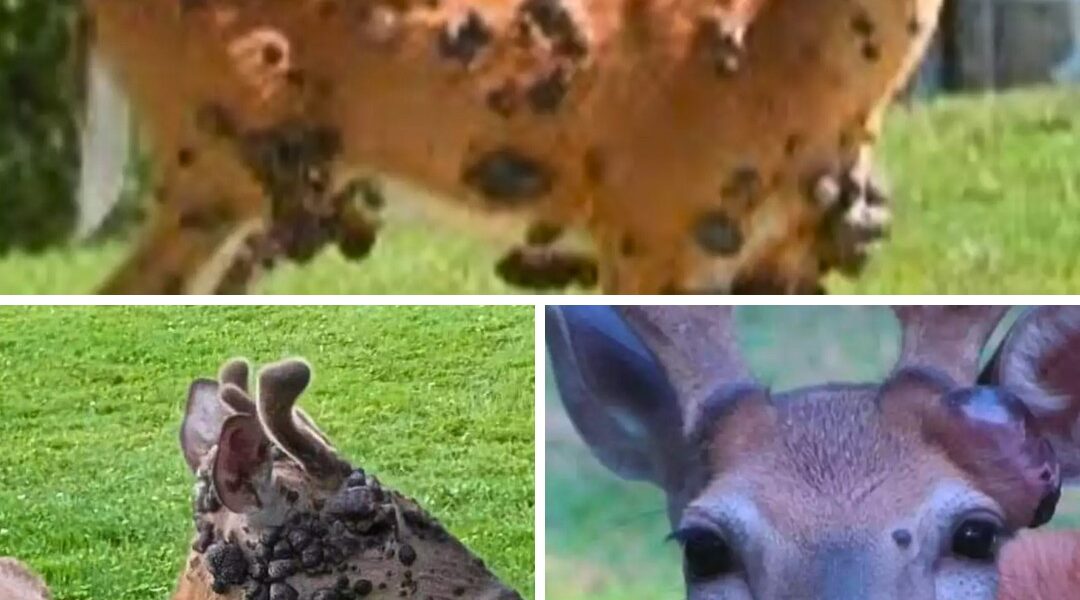‘Mutant deer’ spotted with terrifying flesh bubbles as fears grow of animal outbreak in the US
The ‘mutant species’ trend across America continues with ‘black-bubbled’ deer.
Even though we’ve all only just recovered from Colorado’s poor ‘Frankenstein rabbits’ and ‘zombie’ squirrels, now it’s time to introduce some other growth-ravaged mammals over in Pennsylvania and Wisconsin.
Pictures spreading – for lack of a better word – through social media showcase several warty deer going about their business.

One person took to Reddit to share a deer that they’d spotted in their backy ard a month ago, writing: “Not sure what’s wrong with her or how we can help. Gunshot wound? Tumor? Fireworks? Prion disease? Don’t know what to do.”
Meanwhile, another posted a picture of a deer with a few lumps on its chest and face to ask, ‘what’s wrong with this deer?’
Well, what’s wrong with these deer?
What is deer fibroma?
According to the Maine Department of Inland Fisheries and Wildlife, these fatty lumps are the result of a condition called deer fibroma, which they say is caused by ‘a species-specific papillomavirus’ – similar to the cottontail rabbit papilloma virus (CRPV) affecting bunnies.

The website continues: “These manifest as firm, warty growths fixed to the skin of a deer. They vary in size (though most are just a few centimeters in diameter), are typically dark in color and bare of fur, and often appear fissured or lumpy.”
They add that most infected deers ‘have just a small number of small fibromas, but cases of large fibromas and fibromas widespread about the hide are not uncommon’.
Is deer fibroma contagious to humans?
Similar to CRPV, deer fibroma cannot be spread to humans or other animals outside of other deer.
Dr. Kristin Mansfield, a wildlife veterinarian in Washington state, told FOX13 that deer can spread the virus to one another by sharing either the same feeding ground, sleeping spot, or rubbing posts – typically a tree bucks use to mark their territory during mating season.
They can, however, initiate illnesses such as Lyme disease in populated areas, which crosses species through the ticks they carry.
Mercifully, the animals’ immune system beats away the virus, and the warts eventually shrink and disappear after a few months.

Can deer fibroma be treated?
So far, there is no effective treatment for the condition, with it being possible for lumps on captive animals to be removed surgically.
However, the best course of action is to leave the infected deer be. In worst-case scenarios, if the warts are rendering the deer unable to eat, move or see, then euthanasia is considered as a possible option.
What is possibly causing the rise in ‘animal mutations’?
One of the possible reasons why these conditions are spreading is climate change, as warmer weather is allowing mosquitoes and ticks to thrive.
Alluding to the ramifications of climate change, Dr. Omer Awan of the University of Maryland School of Medicine told The Daily Mail: “These temperature changes are resulting in diseases that were never endemic in certain areas to become endemic.
“If you take a look at Lyme disease, for example, we’re starting to see it in areas that we never saw it before… places like southern Canada, northern states on the East Coast, like Maine.
“People are starting to talk about it more, they’re starting to document it more on social media, and hence, there’s been a lot more discussion about this.”
Source: unilad.com

